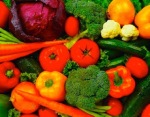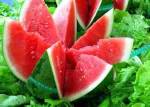Sometime ago, I mentioned that Dr. Andrew Weill was my health guru. I felt that way after my now deceased best buddy introduced me to the wonders of healthy eating. I miss her… and him.
Why him? As you know a healthy diet is not a renal healthy diet. I still subscribe to his Nutrition Newsletter. Today, vegetables and fruits were discussed including some excellent advice, but not for us as Chronic Kidney Disease patients.
Colorizing Your Diet
Phytonutrients – the chemical compounds in plants that appear to protect health, but are not established as essential nutrients – are generally concentrated in the skins of many vegetables and fruits, and are responsible for their vibrant hues, scents and flavors. Some phytonutrients are powerful anti-inflammatory agents; others modulate and enhance immune function, maintaining the body’s healing system while keeping abnormal inflammation in check; and still others boost antioxidant defenses to protect DNA and other cellular components from toxic insults that can cause direct harm, or can promote abnormal inflammation leading to tissue damage.
 In order to get the full range of protective phytonutrients, you should “colorize” your diet: include fresh produce from all parts of the color spectrum and aim for one serving per day (one-half cup cooked or one cup raw) of a fruit or vegetable from all the various color groups (red, red-purple, orange, orange-yellow, yellow-green, green and white-green).
In order to get the full range of protective phytonutrients, you should “colorize” your diet: include fresh produce from all parts of the color spectrum and aim for one serving per day (one-half cup cooked or one cup raw) of a fruit or vegetable from all the various color groups (red, red-purple, orange, orange-yellow, yellow-green, green and white-green).
Okay, we’re pretty sure CKD is an inflammatory disease so this would make sense. We already have compromised systems, so we can use that immune function enhancement. And we certainly won’t say no to something that can protect our cells and DNA from toxic insults. So what’s the problem?
Let me answer it this way. In Chapter 8: The Renal Diet of What Is It and How Did I Get It? Early Stage Chronic Kidney Disease on page 73
In order to fully understand the renal diet, you need to know a little something about electrolytes. There are the sodium, potassium, and phosphate you’ve been told about and also calcium, magnesium, chloride and bicarbonate. They maintain balance in your body. This is not the kind of balance that helps you stand upright, but the kind that keeps your body healthy. Too much or too little of a certain electrolyte presents different problems. Eating a larger portion than suggested in the renal diet of a low sodium, phosphate, protein or potassium food is the equivalent of eating a high sodium, phosphate, protein or potassium food.
So it’s not just eating the fruits and vegetables from each color group. We need to analyze the electrolytes in each serving, especially the phosphate and potassium. I also can only eat three servings of fruits and three of vegetables rather than the seven Dr. Weil recommends.
Why the restrictions of the electrolytes?
Let’s take a look at potassium. Potassium is not a bad thing if you don’t have CKD. It dumps wastes from your cells and helps the kidneys, heart and muscles to function normally. However, too much can cause irregular heartbeat and even heart attacks. Your kidneys are not doing an effective job of filtering the potassium in your blood. You have CKD. This should explain the connection between CKD and cardiovascular events.
And phosphorous? I’ll quote from What Is It and How Did I Get It? Early Stage Chronic Kidney Disease again here since I like the simple direct way I explained it on page 76.
This is the second most plentiful mineral in the body and works closely with the first, calcium. Together, they produce strong bones and teeth. 85% of the phosphorous and calcium in our bodies is stored in the bones and teeth. The rest circulates in the blood except for about 5% that is in cells and tissues. Again, phosphorous is important for the kidneys since it filters out waste via them. Phosphorous balances and metabolizes other vitamins and minerals including vitamin D which is so important to CKD patients. As usual, it performs other functions, such as getting oxygen to tissues and changing protein, fat and carbohydrate into energy.
Be aware that kidney disease can cause excessive phosphorus. And what does that mean for Early Stage CKD patients? Not much if the phosphorous levels are kept low. Later, at Stages 4 and 5, bone problems including pain and breakage may be endured since excess phosphorous means the body tries to maintain balance by using the calcium that should be going to the bones. There are other consequences, but this is the one most easily understood.
 To complicate matters even more, CKD patients are limited to different servings sizes of different fruits and vegetables, not the straight across the board ½ cup cooked or 1 cup raw of each Dr. Weil suggests. For example: I can eat ½ cup of broccoli, but only 1/3 cup of raisins. It depends upon the electrolytes in the particular fruit and vegetable and how much of that specific electrolyte you’ve eaten that day.
To complicate matters even more, CKD patients are limited to different servings sizes of different fruits and vegetables, not the straight across the board ½ cup cooked or 1 cup raw of each Dr. Weil suggests. For example: I can eat ½ cup of broccoli, but only 1/3 cup of raisins. It depends upon the electrolytes in the particular fruit and vegetable and how much of that specific electrolyte you’ve eaten that day.
*sigh* I miss the days of having Dr. Weil as my health guru.
I found even more reviews and all five stars! I am so enjoying this. Thank you all for the reviews.
I was just diagnosed with Chronic Kidney disease Stage 4 a few weeks ago and I want to THANK YOU very much for this book. I put it on my Kindle. It is written in a way that one newly diagnosed and not in the medical field can understand.
Gail Rae has provided a good insight to the bombshell that befalls millions of unsuspecting humans worldwide. A CKD victim myself with years of experience under my belt, found the book extremely informative and a great reference when providing peer support to newly diagnosed sufferers of this silent killer.
So much good information for Chronic Kidney Disease Patients, from beginning to end. Thank you Gail Rae.
Ms. Rae knows, in my opinion, what she is talking about. She is direct-to the point-and the book is easily understood. She has just a hint of humor in her writing which keeps the reader engaged. Will keep this in my reference library.
Until next week,
Keep living your life!



Excellent blog entry Gail! Thanks for sharing your knowledge.
Thank you, Geo. Always glad to have approbation, especially from you!